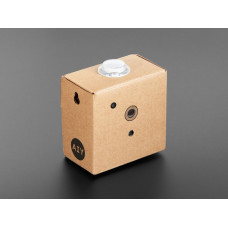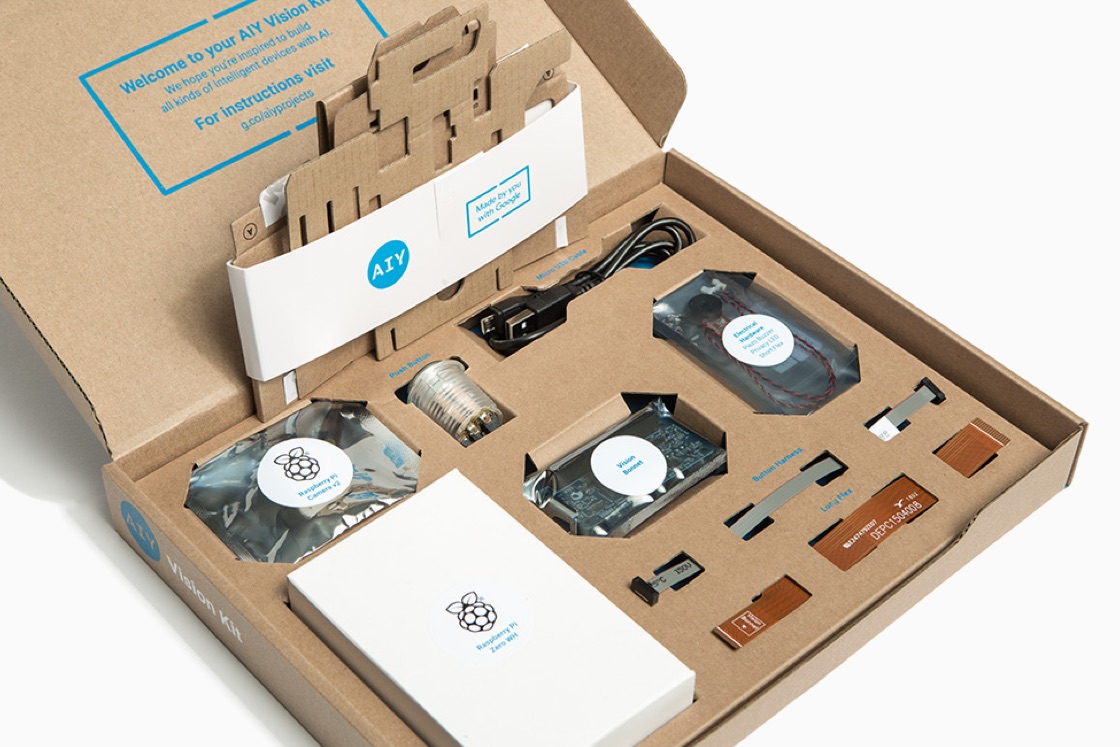Google AIY Vision Kit 1.1
Introduction
The AIY Vision Kit from Google lets you build your own intelligent camera that can see and recognize objects using machine learning. All of this fits in a handy little cardboard cube, powered by a Raspberry Pi.
Everything you need is provided in the kit, including the Raspberry Pi.
Meet your kit
Welcome! Let’s get started
The following instructions show you how to assemble your AIY Vision Kit, connect to it, and run the Joy Detector demo, which recognizes faces and detects if they're smiling.
Then you can try running some other demos that detect other kinds of objects with the camera. You can even install your own custom-trained TensorFlow model.
Time required to build: 1.5 hours
Check your kit version
These instructions are for Vision Kit 1.1. Check your kit version by looking on the back of the white box sleeve in the bottom-left corner.
If it says version 1.1, proceed ahead! If it doesn’t have a version number, follow the assembly instructions for the earlier version.
GATHER ADDITIONAL ITEMS
You’ll need some additional things, not included with your kit, to build it:
Micro USB power supply: The best option is to use a USB Power supply that can provide 2.1 Amps of power via micro-USB B connector. The second-best choice is to use a phone charger that also provides 2.1A of power (sometimes called a fast charger). Don't try to power your Raspberry Pi from your computer. It will not be able to provide enough power and it may corrupt the SD card, causing boot failures or other errors.
Below are two different options to connect to your kit. Choose the one that works best for you, based on what you have available:
OPTION 1: USE THE AIY PROJECTS APP
Choose this option if you have access to an Android smartphone and a separate computer.
You’ll need:
- Android smartphone
- Windows, Mac, or Linux computer
- Wi-Fi connection
- Optional: Monitor or TV (any size will work) with a HDMI input
- Optional: Normal-sized HDMI cable and mini HDMI adapter
OPTION 2: USE A MONITOR, MOUSE, AND KEYBOARD
Choose this option if you don’t have access to an Android smartphone.
You’ll need:
- Windows, Mac, or Linux computer
- Mouse
- Keyboard
- Monitor or TV (any size will work) with a HDMI input
- Normal-sized HDMI cable and mini HDMI adapter
- Adapter to attach your mouse and keyboard to the kit. Below are two different options.
Adapter option A: USB On-the-go (OTG) adapter cable to convert the Raspberry Pi USB micro port to a normal-sized USB port. You can then use a keyboard/mouse combo that requires only one USB port.
Adapter option B: Micro USB Hub that provides multiple USB ports to connect to any traditional keyboard and mouse.
Get to know the hardware
Open your kit and get to know what’s inside.
Take note that the Electrical Hardware bag is underneath the Mechanical Hardware bag.
List of materials
IN YOUR KIT
| 1 | Vision Bonnet | x1 |
| 2 | Raspberry Pi Zero WH | x1 |
| 3 | Raspberry Pi Camera v2 | x1 |
| 4 | Long flex cable | x1 |
| 5 | Push button | x1 |
| 6 | Button harness | x1 |
| 7 | Micro USB cable | x1 |
| 8 | Piezo buzzer | x1 |
| 9 | Privacy LED | x1 |
| 10 | Short flex cable | x1 |
| 11 | Button nut | x1 |
| 12 | Tripod nut | x1 |
| 13 | LED bezel | x1 |
| 14 | Standoffs | x2 |
| 15 | Micro SD card | x1 |
| 16 | Camera box cardboard | x1 |
| 17 | Internal frame cardboard | x1 |
Tutorial
Enter the code in the box below:






